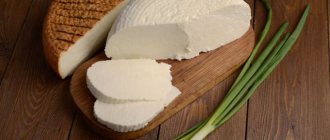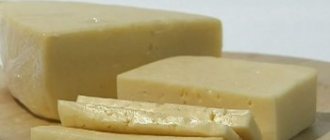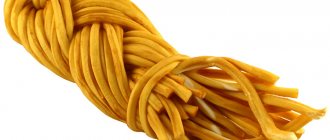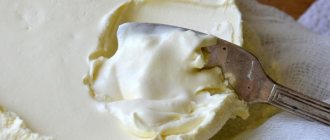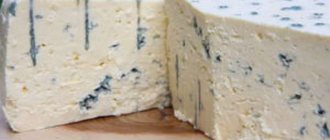Calorie content of cheese: 330 kcal* * average value per 100 g, depends on the type and fat content of the product
Cheese is considered one of the most popular dairy products. Among the huge variety of varieties, everyone can choose the most suitable one for themselves. In total, there are more than 100 varieties, differing in composition, consistency and fat content.
Energy value of cheese of different fat content
An everyday product for dietary nutrition, a favorite children's delicacy with additives and fillers, an exquisite delicacy with a piquant taste - all this is cheese. However, despite the beneficial effect of the product on the gastrointestinal tract, the high content of microelements and amino acids, the recommended daily intake is no more than 40 g. The energy value depends on the method of preparation, fat content and type.
Of the hard and soft varieties of cheese, the latter are considered the most high-calorie with an indicator of about 300 kcal per 100 g, which is 40 units higher than hard ones.
The value indicator for products with fat content of 45% and 50% is the highest - 330 and 380 kcal, respectively. Less dangerous for the figure are varieties with a fat content of 30% and 20% - 240 and 210 kcal. However, they are not suitable for dietary nutrition; it is better to focus on options in which the percentage of fat does not exceed 6%. These are, for example, tofu, light “Chechil”, “Oltermani”, “Gaudette”, “Ricotta”. Read about the nutritional composition of different brands of cheese here.
Oltermani cheese 29%
The nutritional value of food products depends on the biochemical composition. Fats contain a large amount of energy - approximately 9 kilocalories per 1 g. One g of saccharides or polypeptide includes approximately four kilocalories. Because of this, foods with a significant amount of lipids, such as rendered fats, fried cutlets, sausages, chocolate, vegetable oils, are considered the most nutritious. Elk meat contains only 1-2% fat, and 100 grams of elk meat contains about one hundred kilocalories; Pig meat contains fifty% fat, and the caloric component of pork is almost 5 times higher.
Food products with a significant liquid content are low in calories and thus do not contribute to the accumulation of extra pounds. These foods include fruits. When vegetables have excess water content, this determines their low calorie content. This applies to various cereals, bread, all legumes, and other food products of plant origin.
The calorie content of each dish or the calorie content of daily menu products in general can be calculated accurately to the calorie level using tables that indicate the nutritional content of specific food products. But, to calculate the number of calories in a plate of borscht, you will need to weigh at least twenty components (cereals, herbs and others) with a certain accuracy, take into account the loss of nutrients during food storage, the percentage of waste, the influence of heat (some vegetables and fruits lose part of the calories, and some become, on the contrary, more caloric than initially, due to the destruction of fiber), the different effects of what is found in any food product on the absorption of nutrients in the prepared recipe, and various other things.
Proteins have less effect on excess body weight gain than triglycerides or simple carbohydrates. In order to protect the body from the undesirable results of excessive consumption of harmful elements, each serving should contain significantly more vegetable food products than meat products. It should be remembered: unprocessed vegetables and fruits always contain a minimum amount of calories and many useful microelements. Dishes made from low-fat meat products and chicken are lower in calories than foods containing large amounts of fat.
Most often, it is not proteins that are to blame for the increase in our mass, but fats and, to a small extent, sugars. Hidden triglycerides are especially harmful. For example, it is possible to remove fat from meat and remove oily skin from chicken, but this is impossible to do in sausages, cakes or sweets. It is well hidden inside foods, and often accounts for half of the total weight of the food. The results of experiments showed that diets with a small amount of fat in food contribute to a person’s weight loss, even if the total calorie content of dishes and products does not decrease.
Thus, despite the obvious fact that weight gain occurs primarily from an excess of lipids in the menu, eliminating excess weight requires a reduction in the total calorie content of all food products.
Types of cheeses
The calorie content of curd cheese is about 320 kcal, but this figure may change if the product contains various additives. The distinctive features of this variety are its delicate taste, similar to cottage cheese, and soft texture. You can find out how many calories are in cottage cheese from our publication.
Hard cheeses with a calorie content of up to 400 kcal are very popular:
- "Russian",
- "Lithuanian",
- "Dutch",
- "Cheddar",
- "Kostroma".
The most famous soft varieties are “Gorgonzola”, “Roquefort”, “Okhotnichiy”, “Medynsky”. The pickle product is not recommended when following a diet due to its high salt and fat content (about 45%). Lighter options are feta and cheese with a small amount of fat (160 kcal), they are ideal for vegetable salads.
Favorite creamy varieties with an energy value of 210 - 280 kcal:
- "Arla"
- "Mascarpone"
- "Philadelphia",
- "Oltermani"
- "Nature".
Delicious sausage cheese (275 kcal), obtained by smoking processed cheese, should not be overused; a homemade product with a calorie content of 115 kcal is much healthier. Blue cheeses (Roquefort, Brie, Camembert) have a value of about 300 kcal.
You should not eat baked or fried foods while on a diet. Despite the excellent taste and crispy crust, it causes serious harm to the figure; the energy value is at least 300 kcal per 100 g.
Calorie content of different types of cheese: how many calories are in 100 grams
If you are a cheese lover and are trying to lose weight, you will most likely find it useful to know how many calories are in cheese. You will also learn about the benefits of the product for health and weight loss, read about the cheese diet and its features.
Many people love cheese. It is used for preparing various dishes, and simply as a snack with tea or coffee. Did you know that this delicacy helps you lose weight? With its help you can say goodbye to extra pounds and even improve your body health.
Compound
To prepare 450 g of product you need 4.5 liters. milk. The concentration of nutrients in cheese is off the charts. The product, in particular, is rich in the following beneficial substances:
- vitamins A, D, K, C, E;
- vitamins B6 and B12;
- vitamin B1, B3, B7 and B5 (better known as pantothenic acid);
- folate (B complex vitamin);
- calcium;
- riboflavin;
- iodine;
- zinc and copper;
- chromium;
- iron;
- phosphorus;
- magnesium;
- unsaturated fatty acids - Omega-3 and Omega-9.
Cheese is an excellent source of protein. For example, a large slice of Cheddar (weighing 30 g) contains 6.7 g of protein. You'll get the same amount of protein from drinking a cup of milk.
Benefit for health
- First of all, the product is good for teeth.
After all, it contains a large amount of calcium and a small amount of lactose. Scientists have found that regular consumption of cheese reduces the risk of dental plaque. It promotes the deposition of phosphorus and calcium in the teeth, which in itself contributes to the strength of tooth enamel. A high-quality protein called casein forms a protective film on the surface of the teeth, which protects our teeth from damage. - The use of this product is an excellent cancer prevention.
It contains linoleic acid and sphingolipids. These substances protect the body from the harmful effects of free radicals. Vitamin B is also responsible for reducing the risk of developing cancer. Regular consumption of cheese improves the functioning of the body and helps to avoid tumors in the ovarian and prostate areas. - The product is rich in vitamins, macro- and microelements, so its regular consumption improves the functioning of the body's immune system.
- Cheese contains an amino acid called tryptophan. It helps relieve stress and improves sleep.
- Children, pregnant women and the elderly should eat cheese regularly.
Calcium and vitamin B are essential for the formation and strengthening of cartilage and bones. And the excipients, a considerable dose of which are contained in the product, contribute to better absorption of calcium. - For osteoporosis, it is not enough to consume calcium (after all, it is poorly absorbed without the accompanying components).
You need protein and a whole range of vitamins, with which the product is enriched. Therefore, it is worth paying special attention to cheese for children with insufficient body weight, as well as women after menopause. - If you suffer from migraines, then you need to include cheese in your diet. Calcium has been proven to help relieve severe headaches.
- Recently it became known that the beneficial substances contained in dairy products help women around the world cope with PMS more easily.
- Cheese should be consumed regularly by pregnant women. Scientists, along with doctors, believe that protein, calcium and B vitamins are simply necessary for expectant mothers to give birth to healthy and strong babies.
- Unsaturated fatty acids contained in the product reduce the risk of developing diabetes.
- Cheese is no less useful for people who play sports. A considerable amount of protein allows the body to recover faster after intense training. Phosphorus reduces muscle pain.
- Scientists have proven that eating cheese improves heart function.
Although 15-25 g of cheese per day is not contraindicated for people suffering from hypertension, they should choose a product with a low salt content. This will avoid spikes in blood pressure. A cheese diet for people with cardiovascular diseases should be based on the consumption of Feta, Mozzarella and Ricotta.
The substances contained in this product help improve the condition of hair, nails and skin. I would like to debunk the myth that cheese should not be consumed if you have skin problems. Many people think so, since it contains a considerable amount of fat. However, B vitamins contribute to the regeneration of the dermis, its natural radiance and healthy complexion. Given this fact, it is not surprising that the wine and cheese diet is so popular among Italian and French beauties.
The benefits of cheese for weight loss
- Regular consumption leads to fat burning.
- Milk fats activate metabolism.
If you are trying to lose weight, then you should stop eating Dutch, Kostroma, Smetankova (the calorie content of which is 340-360 kcal per 100 g). Goat cheese, which contains 364 kcal, is also contraindicated during the diet.
https://www.youtube.com/watch?v=w45Nejk3OJM
Instead choose:
- Mozzarella cheese (280 kcal per 100 g).
- Gouda 7% (calorie content of Gouda cheese is 200 units). Camembert has the same nutritional value.
- Feta and cheese.
- Ricotta (since it is made from whey and its fat content is very low - from 8 to 24%). The calorie content of Ricotta cheese per 100 g is 174 kcal.
- Tofu (76 kcal.).
Although Pigtail and Chechil (which have 313 calories) are recommended as low-fat foods, you should be careful with them. They contain a considerable amount of salt and hot spices, which can cause a burning appetite and cause water retention in the body. The same applies to Suluguni (290 kcal).
Features of the cheese menu for weight loss
The French diet is ideal for gourmets who cannot live a day without this aromatic delicacy with a pronounced taste. The “10 cheeses” diet belongs to the protein category, therefore it is contraindicated for:
- pregnancy;
- atherosclerosis and hypertension;
- diabetes;
- kidney and liver diseases.
A cheese diet for weight loss involves drinking a lot of water. In addition to juices, tea and coffee, you must drink at least 2 liters. clean water per day.
The diet menu is oversaturated with protein (in the form of meat, cheese, milk) and very poor in vegetables and carbohydrates. But carbohydrates give us vital energy, so we cannot exclude them from the diet. Although the creators of the diet recommend sticking to it for 5-7 days, we recommend limiting it to 3 days.
Culinary tricks for cheese lovers
If you can’t imagine breakfast without a sandwich or a snack without a salad, but are worried about the calorie content of your favorite food, we offer several options on how to reduce their harm to your figure.
- Do you like sandwiches with mayonnaise? Did you know that a spoon of mayonnaise is 94 kcal. and as much as 10 g of fat?! For those who want to lose weight, we recommend spreading cream cheese on toast. For example, Mozzarella cheese, the calorie content of which is 30 g per spoon, contains only 2.5 g of fat.
- You can reduce the calorie content of a sandwich with butter and cheese if you replace Russian cheese with a product labeled “Fitness”.
- Fruit salad dressed with sour cream is a delicious dessert similar to yogurt. But 30 g of this fermented milk sauce contains 110 kcal. and 11 g fat. Nutritionists recommend filling the fruit mix entirely with Ricotta or 50/50 with sour cream. Ricotta contains 39 kcal. and 2 g fat. Also, spreadable cheese can be used to stuff bell peppers and eggs.
- But for preparing spaghetti or baked dishes, it is better to use the classic version - Parmesan. The calorie content of Parmesan cheese is 431 kcal, but this is not scary. After all, it has a richer taste and aroma, so it should be added to dishes in small quantities.
- The taste of vegetable salads should be enriched with feta cheese or feta. These cheeses will not harm your figure at all. The calorie content of Feta cheese and feta cheese is 260 kcal.
Harm
It's hard to imagine that this essential product could harm anyone. However, doctors advise caution when handling blue cheeses, which contain bacteria. They can contribute to the development of listeriosis. This is especially true for pregnant women and during the lactation period.
Experts recommend consuming no more than two servings of cheese per day. Eating it in excessive quantities in rare cases can cause very severe headaches and sleep disturbances. This is due to the content of tryptophan in the product (an amino acid that is not produced by our body).
Myths
Some people who are lactose intolerant believe that they should not eat cheese. In fact, compared to other dairy products, cheese contains too little lactose. Therefore, the product can be safely consumed regularly in small quantities.
There is an opinion that eating a lot of cheese leads to constipation. But there is absolutely no scientific evidence about its effect on the functioning of the gastrointestinal tract.
To lose weight, you don't have to eat only low-fat varieties. For example, even though the calorie content of Russian cheese is 363 units per 100 g, you can eat it. But at the same time, it is necessary to regularly calculate the caloric content of the diet in order to maintain a calorie deficit.
Cheese calorie table
Here is a table showing the calorie content of the most popular varieties of cheese:
Name Amount of kcal. per 100 g.
| Adyghe | 240 |
| Bree | 291 |
| Goat milk cheese | 271 |
| Cow's milk cheese | 260 |
| Sheep's milk cheese | 298 |
| Bukovinian | 361 |
| Viola | 305 |
| Gouda | 356 |
| Dutch | 352 |
| Gruyere | 395 |
| Home | 113 |
| Dor blue | 354 |
| Camembert | 290 |
| Sausage | 271 |
| Smoked | 270 |
| Maasdam | 350 |
| Mozzarella | 240 |
| Oltermanni | 270 |
| Poshekhonsky | 350 |
| Baltic | 309 |
| Roquefort | 337 |
| Russian | 363 |
| Creamy Cremette | 270 |
| Suluguni | 290 |
| Hard Parmesan | 369 |
| Tilsiter | 334 |
| Feta | 215 |
| Fetaki | 219 |
| Fetaxa | 261 |
| Cheddar | 392 |
| Swiss | 396 |
| Estonian | 350 |
| Yaroslavsky | 350 |
Popular brands with calorie content
Each brand of dairy product in question differs not only in cost, but also in energy value. When following a certain nutritional system, it is important to take this into account and choose low-fat cheeses.
The most common dietary one is “tofu”, rich in protein and microelements, its calorie content is only 90 kcal.
190 kcal is contained in 100 g of a low-fat product called “President Camembert”. "Cheddar" with a fat content of 18% (270 cal) can be used to prepare low-calorie dishes. Approximately the same indicator is for “suluguni”, “feta”, sheep and cow cheese.
The caloric content of the most popular cheese in the country, “Rossiysky”, with a fat content of 50%, is 363 kcal, while “Parmesan” is 30 units more.
Delicious, with a delicate texture, “Mascarpone” (412 kcal) is used for making desserts. Low-fat varieties include “Kosichka” and “Chechil” (about 300 kcal), as well as “Mozzarella” (240 kcal). The calorie content of the popular Hochland varies from 260 to 290 kcal per 100 g.
For “Adygei” and “Osetinsky” the indicators are 240 and 360 kcal, respectively. “Adyghe” cheese is easily digestible and is rich in nutrients; it is often included in the diet of athletes and children. The product increases stamina, it is what contributes to the longevity of the inhabitants of the Caucasus.
Brief historical background
The production of lactose-free cream cheese was launched in 1980. The new product appeared on the 75th birthday of Valio. The cheese wheels were presented to all the farmers who supplied milk to the company so that they could take a sample and share their impressions. Within a year, Oltermani appeared on grocery store shelves around the globe. The first batch was small to avoid possible risks, but it sold out so quickly that the company had to work extra hard to resume supplies. Since 1998, Valio has launched a diet version of the cheese with a fat content of 17%.
Fact. The greatest demand for lactose-free cheese is recorded in Finland. Oltermani has been number one in sales there for several years.
Calories in processed cheese and dishes with them
Processed cheeses are cheese curds with a calorie content of 180 to 320 kcal with the addition of whey, salt and various flavor enhancers. The energy value of “Russian Melted” is 300 kcal. Approximately the same numbers are observed for the Hochland sandwich in slices and Sovetsky.
The best option for losing weight is “President Light for Sandwiches” (180 kcal).
You can prepare delicious hot dishes from processed milk product. The calorie content of cheese soups per 100 g is 44 kcal, in one plate of 260 g - about 115 kcal. These figures are relevant if the dish includes 2 processed cheese, 1 onion, 3 potatoes and a little low-fat cream.
How is it useful?
In addition to the beneficial properties inherent in cheeses, Oltermani has a number of features:
- does not contain dyes, flavors, milk fat substitutes, vegetable oils, therefore it rightfully has the status of an environmentally friendly natural product;
- This is an invaluable product for lactose intolerant cheese lovers.
- due to its low fat content and small amount of salt, it is considered low-calorie, gives a long-lasting feeling of fullness and is included in dietary recipes;
- due to its high protein content with a minimum of calories, it is popular among athletes;
! Interesting: all types of Oltermani brand cheese contain only 0.01% lactose, which is confirmed by laboratory tests.
Oltermani goes perfectly with fruits, vegetables and nuts, perfectly complements salads, main courses, desserts, and enriches the body with healthy vitamins and microelements.
Review of calorie content of products containing cheese
When dieting, it is important to select ingredients for dishes whose consumption will not affect your figure. According to statistics, the best-selling cheeses are those whose fat content ranges from 50 to 70%. However, for weight loss this figure should not go beyond 20%.
An example of healthy dishes with low nutritional value is tomatoes or macaroni and cheese (90 and 150 kcal).
The following are considered “heavier”: Georgian khachapuri with feta cheese (300 kcal); pizza with the addition of Parmesan, Gorgonzola, Emmental or Mozzarella (280 kcal). If you prepare khachapuri from lavash, the value will drop to 250 kcal. Puff pastries with Lambert and ham have a calorie content of 240 kcal, and a puff pastry with Emmental and feta cheese has 270 kcal per 100 g.
How many calories are in a cheese sandwich?
The energy value of a sandwich is determined by its components. If the composition contains only bread and hard cheese, then its calorie content is 150-250 kcal. When adding butter, the indicator increases by 60 kcal, and sausage - by 50 kcal.
If the sandwich is made with lean ham or chicken breast, then the value will be 160 kcal (about 10% of the daily calorie intake). During a diet, it is best to use cheeses with a fat content of up to 20% to prepare snacks, and replace bread with whole grain bread. Read about the calorie content of bread in our article.
Cheese is nutritious, has great taste and can be used as an ingredient in many dishes. For your diet, you should buy a variety with minimal fat content.
Oltermani cheese is brown. Description
Oltermanni cheese is a Finnish milk cheese with a centuries-old history. In Russia, they learned about such a product a little more than 20 years ago, when in 1994 a representative branch of the Valio company opened in St. Petersburg. Oltermani is made only in Finland from organic cow's milk. The hallmark of the cheese is its delicate creamy taste with a slight sourness.
Interesting! Monopoly rights to the production of Oltermani cheese belong to the Valio brand (1905).
Features of Oltermanni cheese
A light sweet and sour aftertaste with a barely noticeable bitterness opens gradually. You can enjoy its unusual natural taste thanks to high-quality raw materials and the absence of flavoring and aromatic components. The cheese has a neutral aroma and a small amount of salt in its composition, which makes it very versatile in cooking.
To make cheese, a non-animal rennet enzyme, chymosin, is used. It curdles the milk and separates the cheese grains from the waste liquid while still keeping the cheese low in calories. Thanks to these features, it is suitable for any consumer.
During the ripening process, the cheese acquires a unique structure and aroma. Over the course of a month, milk proteins are broken down into other substances and give Oltermani its characteristic taste and smell.
Did you know... To prepare 1 kilogram of Oltermani cheese, about 10 liters of raw milk are consumed.
Product range
Types of cheese differ in the amount of fat and taste. There are four main types of cheese on supermarket shelves, depending on the fat content:
- Oltermani 55%;
- Oltermani 29%;
- Oltermani 17%;
- Oltermani 9%.
By type of packaging:
- head (900g, 500g, 450g, 250g);
- sliced (150g).
Compound
Cheeses contain ingredients identical to the composition of milk, only in concentrated quantities. Oltermani contains especially a lot of calcium and phosphorus, as well as a complex of vitamins B1, B12, A, E, PP, C, D. The main components of the cheese:
- milk (pasteurized);
- complex fermentation of lactic acid bacteria;
- rennet extract;
- E509 (hardener calcium chloride);
- salt in small quantities.
Beneficial features
- The high protein content in Oltermani quickly creates a feeling of fullness without compromising your figure and overall health.
- The cheese contains no preservatives, GMOs, dyes, flavor enhancers and other harmful components.
- The ideal ratio of calcium and phosphorus strengthens bone tissue. Therefore, the consumption of cheese is indicated for the elderly, children, women during menopause and patients with osteoporosis.
- It is a dietary product due to the small amount of salt and fat.
Use in cooking
Oltermani cheese is simply an indispensable product in the kitchen. Its delicate taste and unobtrusive aroma are ideal for a large number of dishes. It is added to soups, purees, salads, casseroles, snacks and sandwiches. Goes great with fruit salads and nut mixes. But this is just the beginning of his culinary capabilities.
Contraindications
It is recommended to limit the intake of Oltermani cheeses in case of urolithiasis, gastritis and ulcers with high acidity.
Interesting fact! All varieties of Oltermani cheese do not contain lactose, so this product is available for patients with hypolactasia.
